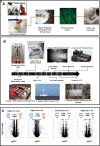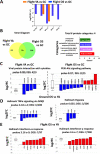Human skeletal muscle tissue chip autonomous payload reveals changes in fiber type and metabolic gene expression due to spaceflight
- PMID: 37714852
- PMCID: PMC10504373
- DOI: 10.1038/s41526-023-00322-y
Human skeletal muscle tissue chip autonomous payload reveals changes in fiber type and metabolic gene expression due to spaceflight
Abstract
Microphysiological systems provide the opportunity to model accelerated changes at the human tissue level in the extreme space environment. Spaceflight-induced muscle atrophy experienced by astronauts shares similar physiological changes to muscle wasting in older adults, known as sarcopenia. These shared attributes provide a rationale for investigating molecular changes in muscle cells exposed to spaceflight that may mimic the underlying pathophysiology of sarcopenia. We report the results from three-dimensional myobundles derived from muscle biopsies from young and older adults, integrated into an autonomous CubeLab™, and flown to the International Space Station (ISS) aboard SpaceX CRS-21 as part of the NIH/NASA funded Tissue Chips in Space program. Global transcriptomic RNA-Seq analyses comparing the myobundles in space and on the ground revealed downregulation of shared transcripts related to myoblast proliferation and muscle differentiation. The analyses also revealed downregulated differentially expressed gene pathways related to muscle metabolism unique to myobundles derived from the older cohort exposed to the space environment compared to ground controls. Gene classes related to inflammatory pathways were downregulated in flight samples cultured from the younger cohort compared to ground controls. Our muscle tissue chip platform provides an approach to studying the cell autonomous effects of spaceflight on muscle cell biology that may not be appreciated on the whole organ or organism level and sets the stage for continued data collection from muscle tissue chip experimentation in microgravity. We also report on the challenges and opportunities for conducting autonomous tissue-on-chip CubeLabTM payloads on the ISS.
© 2023. Springer Nature Limited.
Conflict of interest statement
S.M. is a non-paid member of the board at Micro-gRx, INC. All other authors declare they have no conflicts of interest with the contents of this article.
Figures


Update of
-
Validation of Human Skeletal Muscle Tissue Chip Autonomous Platform to Model Age-Related Muscle Wasting in Microgravity.Res Sq [Preprint]. 2023 Mar 29:rs.3.rs-2631490. doi: 10.21203/rs.3.rs-2631490/v1. Res Sq. 2023. Update in: NPJ Microgravity. 2023 Sep 15;9(1):77. doi: 10.1038/s41526-023-00322-y. PMID: 37034730 Free PMC article. Updated. Preprint.
Similar articles
-
Validation of Human Skeletal Muscle Tissue Chip Autonomous Platform to Model Age-Related Muscle Wasting in Microgravity.Res Sq [Preprint]. 2023 Mar 29:rs.3.rs-2631490. doi: 10.21203/rs.3.rs-2631490/v1. Res Sq. 2023. Update in: NPJ Microgravity. 2023 Sep 15;9(1):77. doi: 10.1038/s41526-023-00322-y. PMID: 37034730 Free PMC article. Updated. Preprint.
-
Microgravity accelerates skeletal muscle degeneration: Functional and transcriptomic insights from an ISS muscle lab-on-chip model.Stem Cell Reports. 2025 Jul 8;20(7):102550. doi: 10.1016/j.stemcr.2025.102550. Epub 2025 Jun 26. Stem Cell Reports. 2025. PMID: 40578352 Free PMC article.
-
Microphysiological system for studying contractile differences in young, active, and old, sedentary adult derived skeletal muscle cells.Aging Cell. 2022 Jul;21(7):e13650. doi: 10.1111/acel.13650. Epub 2022 Jun 2. Aging Cell. 2022. PMID: 35653714 Free PMC article.
-
Spaceflight bioreactor studies of cells and tissues.Adv Space Biol Med. 2002;8:177-95. doi: 10.1016/s1569-2574(02)08019-x. Adv Space Biol Med. 2002. PMID: 12951697 Review.
-
Is skeletal muscle ready for long-term spaceflight and return to gravity?Adv Space Biol Med. 1999;7:31-48. doi: 10.1016/s1569-2574(08)60006-4. Adv Space Biol Med. 1999. PMID: 10660772 Review.
Cited by
-
Microphysiological systems to advance human pathophysiology and translational medicine.J Appl Physiol (1985). 2024 Nov 1;137(5):1494-1501. doi: 10.1152/japplphysiol.00087.2024. Epub 2024 Oct 17. J Appl Physiol (1985). 2024. PMID: 39417817 Review.
-
Progress in the Application of Organoids-On-A-Chip in Diseases.Organogenesis. 2024 Dec 31;20(1):2386727. doi: 10.1080/15476278.2024.2386727. Epub 2024 Aug 10. Organogenesis. 2024. PMID: 39126669 Free PMC article. Review.
-
Organs in orbit: how tissue chip technology benefits from microgravity, a perspective.Front Lab Chip Technol. 2024;3:1356688. doi: 10.3389/frlct.2024.1356688. Epub 2024 Mar 7. Front Lab Chip Technol. 2024. PMID: 38915901 Free PMC article.
-
Heart-on-a-Chip at the final frontier.Proc Natl Acad Sci U S A. 2024 Oct 8;121(41):e2417412121. doi: 10.1073/pnas.2417412121. Epub 2024 Sep 30. Proc Natl Acad Sci U S A. 2024. PMID: 39348548 Free PMC article. No abstract available.
-
Taking the 3Rs to a higher level: replacement and reduction of animal testing in life sciences in space research.Biotechnol Adv. 2025 Jul-Aug;81:108574. doi: 10.1016/j.biotechadv.2025.108574. Epub 2025 Apr 1. Biotechnol Adv. 2025. PMID: 40180136 Review.
References
-
- Capri M, et al. Long-term human spaceflight and inflammaging: does it promote aging? Ageing Res. Rev. 2023;87:101909. - PubMed
Grants and funding
LinkOut - more resources
Full Text Sources
Molecular Biology Databases

